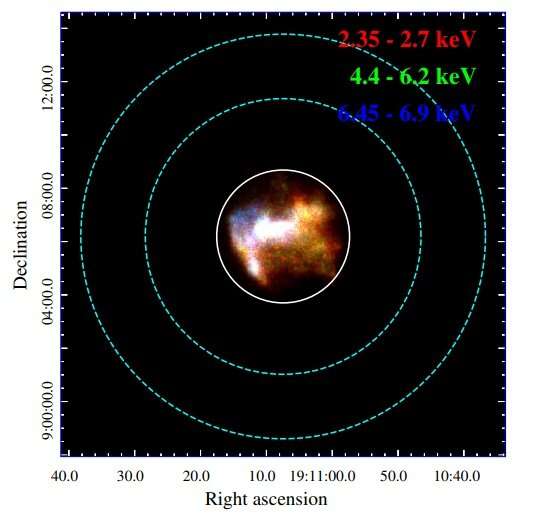March 25, 2020 report
Supernova remnant W49B investigated with XMM-Newton

Chinese astronomers using ESA's XMM-Newton spacecraft have investigated a luminous supernova remnant (SNR) known as W49B. Results of the new study, presented in a paper published March 16 on arXiv.org, shed more light on the properties of this SNR and on the nature of its progenitor.
SNRs are diffuse, expanding structures resulting from a supernova explosion. They contain ejected material expanding from the explosion and other interstellar material that has been swept up by the passage of the shockwave from the exploded star.
Studies of supernova remnants are important for astronomers as they play a key role in the evolution of galaxies, dispersing the heavy elements made in the supernova explosion into the interstellar medium (ISM) and providing the energy needed for heating up the ISM. SNRs are also believed to be responsible for the acceleration of galactic cosmic rays.
Located most likely between 26,000 and 36,800 light-years away from the Earth, W49B is a mixed-morphology SNR. It is one of the first supernova remnants detected with recombining (over-ionized) plasma (RP) and also one of the most luminous SNRs in the Milky Way in the 1.0 GHz radio band or GeV gamma-rays.
The nature of W49B's progenitor remains an open question. The most plausible hypothesis is that it is a core-collapse (CC) supernova, however, some studies propose that it could be a thermonuclear Type Ia SN, or even jet-driven Type Ib/Ic explosion. To find out which scenario is true, Lei Sun and Yang Chen of Nanjing University in China analyzed archival XMM-Newton observations of W49B.
"We perform a comprehensive X-ray spectroscopy and imaging analysis of SNR W49B using archival XMM-Newton data," the astronomers wrote in the paper.
The study found spectral evidence for over-ionization of iron and also lighter elements like silicon, sodium and calcium, in the ejecta-dominated hot plasma of W49B. Moreover, the research constrained thermal and ionization properties of the RP in this SNR.
In particular, the research found that the RP in W49B has a multi-temperature composition and consists of two components with a total mass around 4.6 solar masses. The two components turned out to be both dominated by the ejecta material, but characterized by different electron temperatures (about 1.60 and 0.64 keV) and recombination ages (approximately 6,000 and 3,400 years).
Furthermore, the XMM-Newton data provided line flux images and the equivalent width maps of various emission lines for W49B. Analysis of this dataset indicates that the central bar-like structure of the SNR has the highest emission measure for almost all the emission lines. Meanwhile, the distributions of metal abundances show clear stratified features.
Chemical study of the ejecta in W49B found that the metal abundance ratios support the core-collapse supernova progenitor (with a mass below 15 solar masses) scenario for the studied SNR. However some results point out to other explanation.
"If W49B originates from a CC explosion, our results suggest the progenitor mass to be below 15 solar masses. But the high Mn abundance (Mn/Fe > 1) will be confusing in the CC context. If W49B originates from a Type Ia SN, our results indicate that the metal abundance ratios could be roughly consistent with a DDT [delayed-detonation] model with multi-spot ignition, but the X-ray emitting ejecta only account for ~10 percent of the total SN ejecta," the astronomers concluded.
More information: An XMM-Newton X-ray View of Supernova Remnant W49B: Revisiting its Recombining Plasmas and Progenitor Type, arXiv:2003.07237 [astro-ph.HE] arxiv.org/abs/2003.07237
© 2020 Science X Network




















